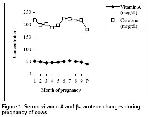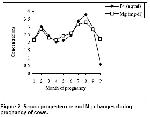Concentrations of vitamin A and β-carotene during
pregnancy period ranged from 40.22±1.53 to 53.85±2.94
μg/dl and 180.44±3.52 to 224.26±8.01 μg/dl, respectively.
Similar results were reported in pregnant cows by
some researchers
2,12,13. The evaluation of serum
vitamin A level in other month, except the 3rd and 4th months of pregnancy, showed statistically significant
decrease (P < 0.001) with the lowest values at the
parturition. The β-carotene levels after parturition were
lower than the 1st, 6th, 7th, 8th, and 9th months of the
pregnancy (P < 0.01). Our findings are comparable to the
data obtained at various month of pregnancy and after
parturition in pregnant cows
2,12,13. Aksakal et al.
14 reported that β-carotene levels were sequentially
177, 190, 168, 263, 125 and 101 μg/dl in the 5, 6, 7, 8
and 9
th months of pregnancy, plasma β-carotene levels
were determined to decrease continually in the late
pregnancy period, and the minimum levels were
observed in the delivery period.
During the last weeks of pregnancy and at parturition
a decrease in vitamin A and β-carotene levels in blood is
very pronounced, probably due to the utilization of
vitamin by cows organism in order to ensure an
abundant intake of this substance of vital importance to a
calf 12. The vitamin A and β-carotene decreases in
plasma of prepartum cows are, according to Thompson
15, probably caused by a vitamin A and β-carotene
transfer to colostrum and not by hormonal changes as
generally stated. It was noted that there was important
correlation between serum vitamin A and ß-carotene
during pregnancy (r= 0.69, P<0.01). Johnston and Chew
16 also determined that there was a significant
correlation between plasma vitamin A and β-carotene
levels in the pregnancy and postpartum periods of the
cows. They also found a correlation in positive (P<0.05)
between serum vitamin A and progesterone; β-caroten
and progesterone during pregnancy. It is claimed that
there is correlation between serum β-carotene levels and
progesterone values, and correlation between serum
vitamin A and progesterone levels in cows 17. In
another study performed with the follicle fluid of
simmental cows 18, correlation between progesterone
and vitamin A was noted. Positive correlation between
progesterone and vitamin A or β-carotene during gestation
indicated that vitamin A and β-carotene together with
progesterone may have an effective role in the development
of corpus luteum which provides the continuation of
pregnancy, and on the initiation of the progesterone
synthesis, as the vitamin A and β-carotene levels in
corpus luteum in the luteal phase is reported to be higher
compared to the other periods of the cycle 19.
The individual results indicated that values of
progesterone increased slightly at 2 month of pregnancy,
declined from 3 to 6 months, increased sharply at 7
month, peaked at 8 month and then rapidly declined a
day after parturition. Eissa et al. 4 concluded that the
concentration of progesterone increased slightly during
the first 2 months and 4 months of pregnancy. Their
values reached peak these levels at 7 month of the
pregnancy period, decreased significantly at days 7
prepartum and dropped sharply to below 1 ng/ml after
parturition 4,20. Eissa and El-Belely 21 reported that
the plasma concentrations of progesterone increased
until the 3rd month of gestation, then decreased
significantly at the 4th month. The higher values of
progesterone during the first trimester of gestation might
be associated with the formation of accessory luteal
tissue arising from an ovulation which frequently occurs
within the gestation period. The obtained results were in
contrast to those previously reported in the pregnant
cows 22. They did not find any differences in plasma
progesterone concentrations during the months of
gestation. The findings are in agreement with that
reported by some researchers 2,20,21.
The serum progesterone profile paralleled the serum
Mg profile throughout gestation and at parturition in the
cows (Fig. 2). Therefore, strong positive correlation
between serum progesterone and Mg was observed in
our study. It was reported that plasma progesterone
concentration was positively (P<0.05) and negatively
(P<0.05) correlated with Mg concentration during
gestation and lactation respectively. Also, during the dry
period, plasma progesterone was positively (P < 0.05)
correlated with Mg 23. The positive correlation between
plasma concentrations of progesterone and Mg during
pregnancy may therefore be a result of parallel increases
of plasma progesterone to maintain the conceptus and
increases of plasma Mg in response to raised metabolic
rate to meet the demands of both the cows and the
growing foetus.
The mean values of Mg during pregnancy and at
parturition ranged from 2.15 to 3.30 mg/dl and they are in
coincidence with the data recorded during pregnancy in
cows of some researchers 24,25. Shahzad et al. 26
reported that level of serum Mg after parturition was
higher than prepartum period with no observed puerperal
disorders. However, gestation period in cows had no
determined effect on concentrotions of Mg 27. In this
study, reached peak 8 month of pregnancy, values of
serum Mg after parturition lower than 8 month of
pregnancy were observed. Similar findings were reported
by Jacob et al. 24 during gestation period in cattle.
These results indicated that Mg levels in cows may be
changeable according to gestation period
Lammoglia et al. 28 reported that on 20 to 14 days
before calving, progesterone concentrations in cows
bearing male calves were greater than those in cows
bearing female calves, but on 13 to 7 days before
parturition, progesterone concentrations were not
significantly different. In contrary, it was observed that
the sex of the foetus in sheep did not seem to influence
plasma progesterone levels and plasma progesterone
concentrations, which do not appear to be a useful tool in
predicting the sex of the foetus 29. In this study,
concentration of serum progesterone during pregnancy
and at parturition in cows carrying male (2.53±0.27
ng/ml) was similar to that in cows carrying famele
(2.49±0.28 ng/ml). These findings were in agreement
with results reported in sheep by Kalkan et al. 29.
In conclusion, according to this study, it is suggested
that gestation period and parturation may influence the
concentrations of serum progesterone, vitamin A, ßcarotene
and Mg of the animals under same condition.
Serum vitamin A, ß-carotene and Mg as well as
progesterone are required for the maintenance of
pregnancy in cows.





